- Reference Number: HEY1435/2024
- Departments: Dietetics, Nutrition Support
- Last Updated: 29 February 2024
The aim of this leaflet is to provide information on the potassium content of foods and drinks that will help you to control your potassium level.
Introduction
Potassium is a mineral found in many foods and drinks. It is required to ensure healthy functioning muscles, including your heart muscle.
Your kidneys normally control the levels of potassium in your blood. When your kidneys are not working properly, this control is lost. It is quite common for people with kidney problems to have too much potassium in their blood.
Too much potassium can be dangerous as it affects the rhythm of your heart and you may have to go to hospital for emergency treatment and heart monitoring if it becomes too high.
There is no reliable way, other than a blood test, to tell if your potassium is high. You can access and monitor your own blood tests online by registering with ‘Patient’s Know Best’. Ask your dietitian for further details.
Using this guide can help you to choose the foods that you enjoy whilst keeping your potassium level well controlled.
How to control your blood potassium levels
- Follow the advice in this booklet to reduce your potassium intake
- Try to ensure regular bowel habits as constipation can increase your potassium level
- If you have diabetes aim to keep your blood glucose levels under control, as poor control can increase your potassium level
- Some medications can cause high potassium levels and your doctor may need to reduce a dose or stop these
- Let your dietitian or doctor know if you are taking any over the counter medicines or supplements (such as multivitamins) as some of these may contain potassium
- It is important that you try to have a balanced diet. This consists of having a variety of foods from different food groups as shown in the following pages.
Your dietitian can help and support you if you need to combine this low potassium diet with any other dietary requirements.
Your need for a low potassium diet may change, depending on your appetite, food preferences and any other medications and treatment for your kidneys.
Processed foods, food labelling and salt
Salt substitutes are becoming more popular and should be avoided as they contain Potassium Chloride to replace some or all of the salt. Some examples are LoSalt, So-Low, Saltneys
In packaged foods, look in the list of ingredients on food labels to see if any potassium has been added. This will be listed either by its full name or by its E number. Look for food additives with “Potassium” in the name.
These may contribute significantly to the potassium content:
| E number | Name of food additive |
| E340 | Potassium phosphates |
| E508 | Potassium chloride |
Potassium is found in other food additives, though usually in small amounts, such as preservatives. If you want further information on this, please ask the dietitian.
Bread, rice, potatoes, pasta, starchy foods and grains
Starchy foods provide energy and vitamins. Some starchy food should be included at each meal.
Foods such as bread, rice and pasta are low in potassium and can be eaten freely. However, some starches like potato are particularly high in potassium and should be limited.
Wholegrain starchy foods contain fibre and help to keep your bowels regular. Less potassium may be absorbed from high fibre foods.
Potatoes
150 grams (5 ounces) 3 egg sized potatoes sized potatoes may be eaten once a day. these may be swapped for 150 grams boiled sweet potato or yam.
Cooking methods
- The way you cook your potatoes and vegetables affects the potassium content. When they are boiled, some of the potassium is lost into the cooking water. This reduces the potassium content of the food. When little or no water is used, most of the potassium stays in the food.
- Boil potatoes and vegetables in plenty of water and make sure they are well cooked. Throw away this water and do not use it to make soups, casseroles or gravy.
- Peel potatoes before boiling when possible.
- Avoid using a steamer, microwave or pressure cooker for cooking potatoes and vegetables. You can use a microwave to reheat previously cooked vegetables or potatoes.
- Par-boil potatoes and vegetables for 5 to 10 minutes, before chipping or roasting or adding to stew, casserole or curries.
- Pasta and rice are much lower in potassium than potatoes. For rice or pasta dishes, you can use half large tin (200 grams) of canned tomatoes instead of potato.
If using quinoa, one portion (40 grams dry weight) can be used instead of potato at a main meal.
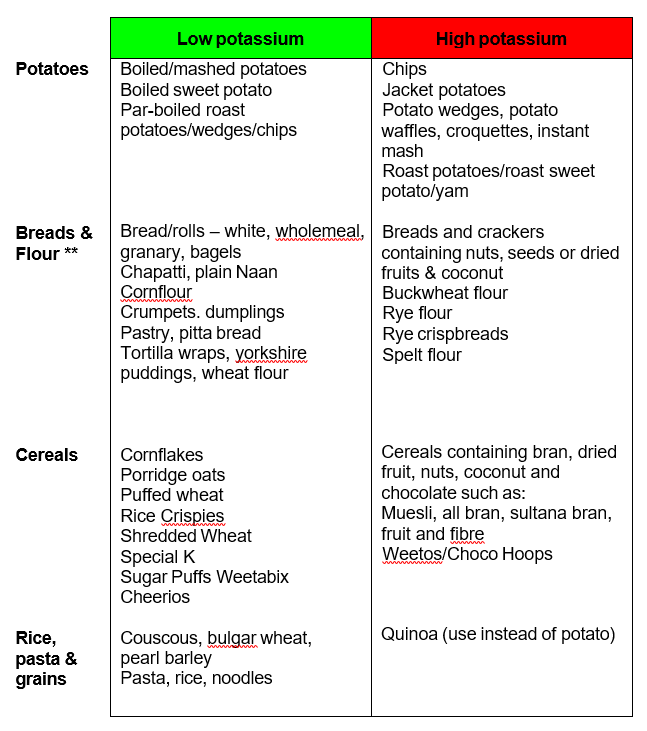
Protein Foods
Meat, fish, seafood, eggs, meat alternatives, nuts, beans, lentils & seeds are good sources of protein, which is important for building and maintaining muscle and for fighting infection.
Nuts, beans, lentils & seeds contain both protein and fibre. Due to their high fibre content, less potassium may be absorbed from these foods. You may include beans and lentils either as part of your vegetable allowance or in place of your meat or fish. Discuss this with your Dietitian if you want to eat these regularly.
Ensure you have these foods at two meals each day to ensure you have enough protein in your diet.
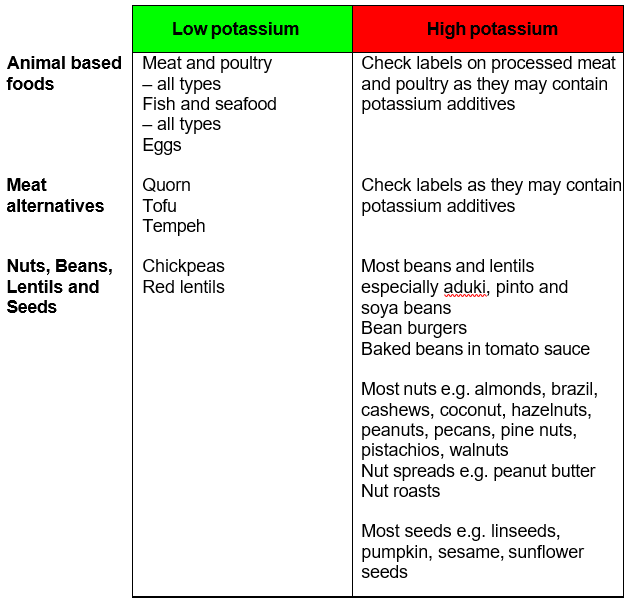
Average serving sizes
Light meal
- 1 to 2 slices cold meat: 30 to 60 grams (1 to 2 ounces)
- Tinned tuna/salmon/mackerel 30 to 60 grams (1 to 2 ounces)
- 1 to 2 eggs
Main meal
- 90 to 120 grams (3 to 4 ounces) cooked weight (about the size of the palm of your hand)
- 3 slices roast meat / 1 average sized chop / 1 chicken breast / 1 fillet of fish
- 2 to 3 eggs
- 3 tablespoons of cooked beans / lentils: 90 grams (3 ounces)
Note:
- All dried beans must be thoroughly cooked before eating
- Up to 1 tsp of seeds may be eaten per day e.g. in seeded bread
Fruit and vegetables
Fruit and vegetables are an important source of vitamins, minerals and fibre and help your bowels open regularly. However, they all contain some potassium though the amount varies. Try to have a variety of fruit and vegetables.
Adults are recommended to have five 80 grams (3 ounces) portions per day.
- An 80 grams (3 ounces) portion of fruit would be about a handful of small fruit (strawberries, raspberries, grapes etc.) or a small apple, peach or tangerine.
- An 80 grams (3 ounces) portion of vegetables is about 3 heaped tablespoons or a small bowl of
- 80g (3oz) portions are quite small. For example, a large handful of grapes (approx. 20 grapes) may weigh about 160g (6oz) so this should be counted as 2 portions.
Fruits to avoid:
- Star fruit – this may cause dangerous side effects for those with kidney problems; it is therefore recommended that you avoid this.
- Grapefruit – you may be advised not to have this if you are taking certain medications.
You can choose 5 portions a day from the following lists, remembering that each 80 gram portion is quite small (about a handful).
For your fruit and vegetables, choose mainly from the low and medium lists. However, you may have one serving of fruit or vegetable taken from the high potassium list per day.
Those fruit and vegetables that are very high in potassium should be avoided or used in very small quantities. Speak to the dietitian for further details.
Fruit
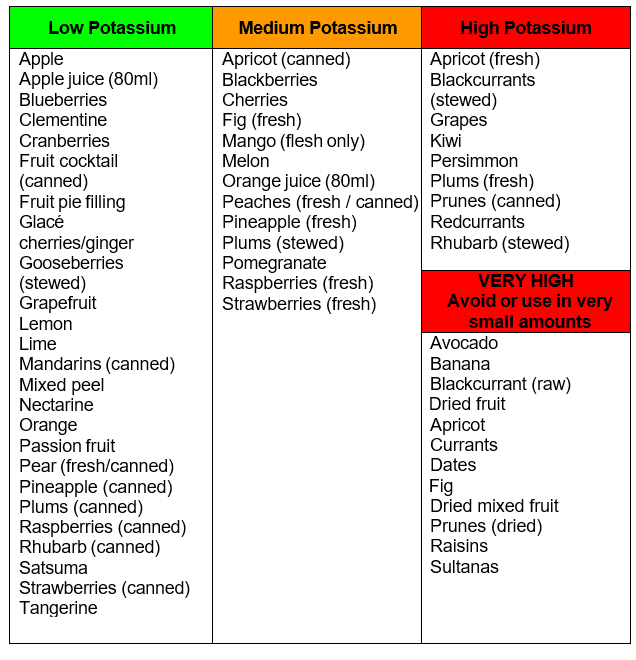
Vegetables
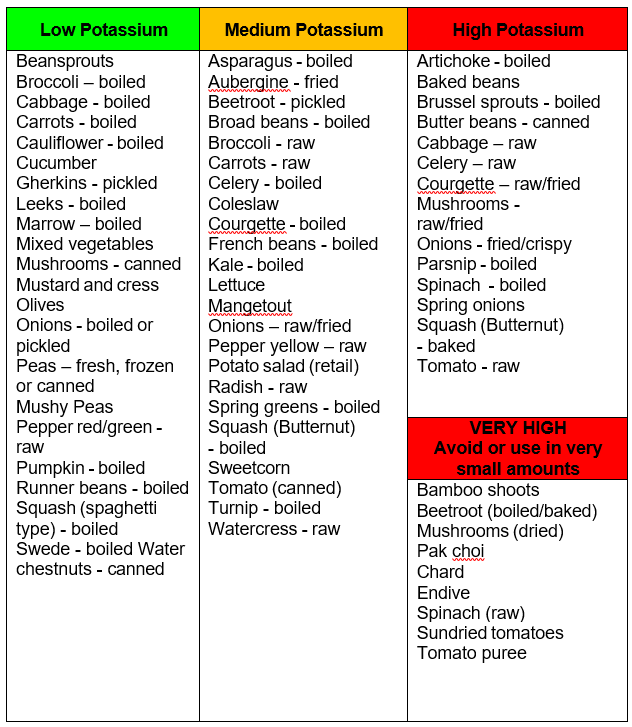
Dairy products and alternatives
Dairy foods such as milk, cheese and yoghurt (and plant based alternatives) are important sources of protein, vitamins and minerals. However, some of these foods are higher in potassium, so it is important not to have too much. Some are naturally lower in potassium and are good choices. In order to have enough protein but not too much potassium, choose from the list below:
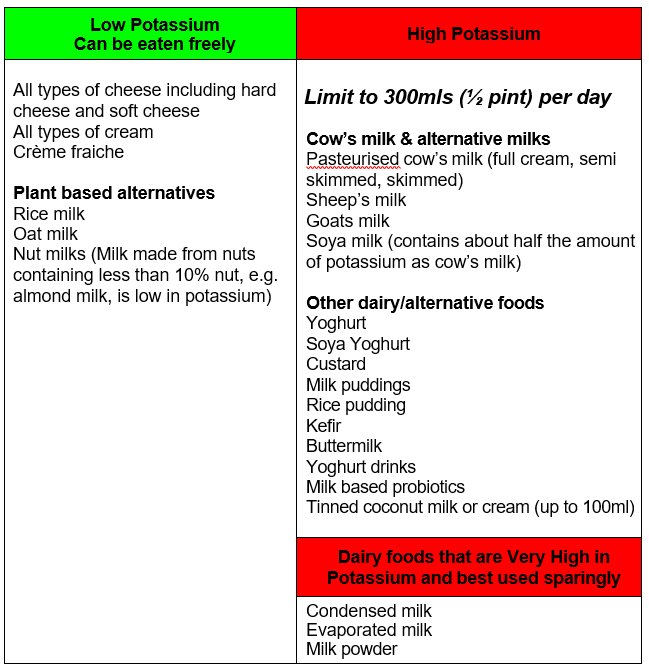
Foods high in fat and/or sugar
These foods are high in calories and some are high in potassium.
Aim to use these foods sparingly. However, if you have a poor appetite or have lost weight recently, ask to speak to the dietitian for further advice on these foods.
Fats and Oils
The following fats/oils are all low in potassium. Those marked ♥ are better for your heart.
| Monounsaturated fats ♥ | Olive oil, rapeseed oil, olive oil based spreads |
| Polyunsaturated fats ♥ | Sunflower, soya, corn oils and margarines made from these oils |
| Saturated fats | Butter, cream, lard and visible fat on meat, coconut oil |

